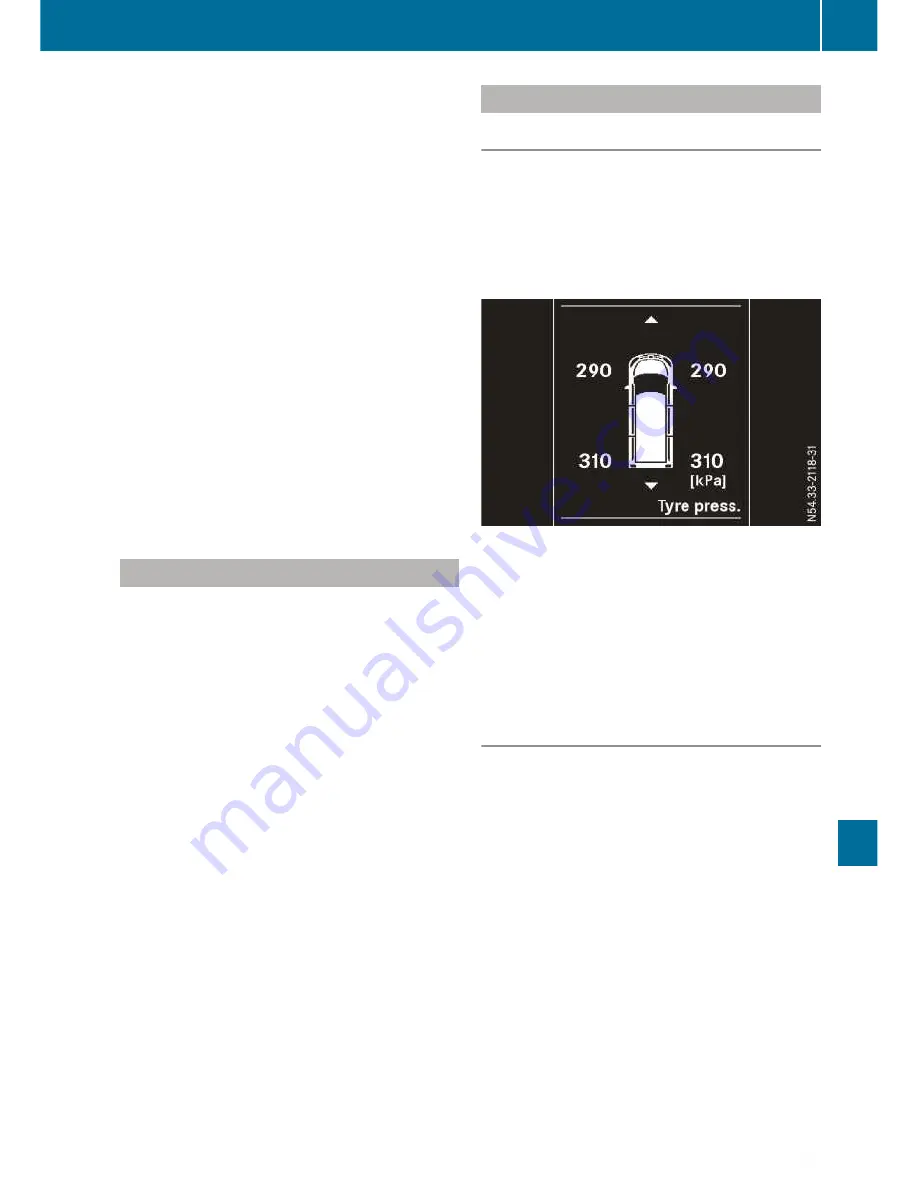
The tyres are cold:
R
if the vehicle has been parked with the tyres
out of direct sunlight for at least three hours
and
R
if the vehicle has not been driven further than
1.6 km
Depending on the ambient temperature, the
speed at which you are driving and the load on
the tyres, the tyre temperature and thus the tyre
pressure changes by approximately 10 kPa
(0.1 bar/1.5 psi) per 10 †. Take this into
account when checking the pressure of warm
tyres. Only correct the tyre pressure if it is too
low for the current operating conditions.
Driving with a tyre pressure that is too high or
too low:
R
shortens the service life of the tyres
R
causes increased tyre damage
R
has a negative effect on handling character-
istics and thus driving safety (e.g. due to
aquaplaning)
Checking the tyre pressure manually
To determine and set the correct tyre pressure,
proceed as follows:
X
Remove the valve cap of the tyre that is to be
checked.
X
Press the tyre pressure gauge securely onto
the valve.
X
Read the tyre pressure and compare it with
the recommended value on the loading infor-
mation table or the tyre pressure table
(
Y
page 359).
X
If the tyre pressure is too low, increase it to
the recommended value.
X
If the tyre pressure is too high, release air by
pressing down the metal pin in the valve. Use
the tip of a pen, for example. Then check the
tyre pressure again using the tyre pressure
gauge.
X
Screw the valve cap onto the valve.
X
Repeat these steps for the other tyres.
Tyre pressure monitor
General notes
In vehicles with a tyre pressure monitor system,
the vehicle's wheels have sensors fitted which
monitor the tyre pressure in all four tyres. The
tyre pressure monitor warns you if the pressure
drops in one or more of the tyres. The tyre pres-
sure monitor only functions if the corresponding
sensors are fitted to all wheels.
Tyre pressure display (only on vehicles with steer-
ing wheel buttons)
On vehicles with steering wheel buttons, the
current pressure of the individual tyres in the
display can be shown via the
Service
menu.
For further information on displaying the current
tyre pressures, refer to "Checking the tyre pres-
sure electronically" (
Y
page 362).
Important safety notes
It is the driver's responsibility to set the tyre
pressure to the recommended cold tyre pres-
sure suitable for the operating conditions
(
Y
page 359).
Note that the correct tyre pressure for the cur-
rent operating conditions must first be program-
med into the tyre pressure monitor. If there is a
substantial loss of pressure, the warning thresh-
old for the warning message is aligned to the
reference values programmed in. Restart the
tyre pressure monitor after adjusting the cold
tyre pressure (
Y
page 363). The current pres-
sures are saved as new reference values. This
will ensure that a warning message will only
appear if the tyre pressure drops significantly.
The tyre pressure monitor does not warn you if a
tyre pressure is incorrect. Observe the notes on
the recommended tyre pressure (
Y
page 359).
Tyre pressure
361
Wheels and tyres
Z






























